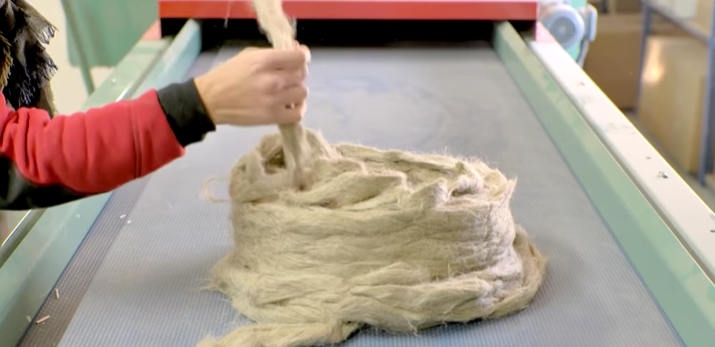Thinking about product life cycles and eco-responsibility
Hemp is certainly a natural product. But what happens at the end of its life, when it has been integrated with other materials? Various research projects are being set up to anticipate the processes and sectors that need to be created to ensure that industrial hemp becomes a fully-fledged eco-responsible resource.
Designing a product means anticipating its end-of-life and the destination of its components. Hemp is no exception to this rule, which makes manufacturers liable. All new projects must integrate the notion of life cycle, environmental impact and, if possible, ecodesign. Used in sectors as varied as textiles, construction and composite materials, particularly for the automotive and plastics industries, industrial hemp can be found in jeans and jumpers, as well as cars, houses and offices. Products with varying life spans. Products that combine fibre with materials of varying degrees of complexity.
‘These issues are clearly integrated into all our projects, and solutions are emerging, but there is still a long way to go,’ says Arnaud Day, Scientific Director at FRD, the leading technological resource centre for plant fibres, based near Troyes, which works on all types of biomass. “We are collecting and developing databases on the recyclability of these materials in conjunction with CODEM. In the case of textiles, for example, this involves planning for the product’s post-use phase: collection of the garments, sorting, deconstruction with separation of the various components such as buttons and fastenings, and finally recycling of the various materials. “As part of a new project, we are making progress on approaches to recycling textiles for use in insulation wools, for example.
Hemp concrete today, fuel tomorrow?
While recycling a jumper made from 100% hemp poses no problem in principle, recycling hemp concrete or composite materials makes the process more complex. Because the lifespan of a house is nothing like that of a garment, and production techniques are constantly evolving. ‘The first hemp concrete houses are already over 35 years old, and the recycling of products can vary depending on the formulations used in the past and those used today,’ explains Guillaume Delannoy, Deputy Head of Industrial Development and Research at CODEM, FRD‘s sister company specialising in construction. “My thesis at IFSTTAR showed in 2018 that hemp concrete is a stable material over time. But we need to identify ways of recovering these materials at the end of their life”. The recently launched ValoBBio project is a step in this direction. “Over the next three years, we will be testing a number of different hypotheses, starting with the deconstruction of hemp concrete. Can the aggregates be recovered? How can we separate the materials, and what route should they take? Will it be used for agricultural or energy purposes, or buried? These are just some of the issues to be explored. So many questions awaiting answers.
Cars: the virtuous circle of recycling
This means that the life cycle of materials made from industrial hemp must now be taken into account, and a large number of research projects are being set up to identify appropriate channels. Others are more advanced, such as plastics processing. In the European automotive sector, for example, since 2015 it has been mandatory to recycle and recover 85% and 95% respectively of vehicle components at the end of their life. ‘The use of hemp in automotive parts as an alternative to polypropylene plastic parts offers advantages in terms of weight reduction (20-30%) and recycling capacity in line with the channels in place,’ adds Arnaud Day. Given the regulatory context, dismantling channels do exist. “They recover the vehicles, dismantle them, sort the waste and recycle certain materials, such as polypropylene.
In this way, the virtuous circle of the product life cycle comes full circle towards a zero waste objective. The boom in the use of industrial hemp in various markets is speeding up research and the creation of new sectors, and several projects are under way on the subject of recycling. Building the biorefinery ecosystem of the aims to encourage synergies between players and pool skills to ensure that hemp is taken into account from its cultivation to its end-of-life. The aim of the Hemp European Hub is to look at the sector as a whole and to support the development of industrial hemp markets in an eco-responsible environment.
Projet ValoBBio
Partenaires : CODEM, IMT Lille-Douai, EVEA
Duration : 3 years
Funding: ADEME and Hauts-de-France Region
Main objectives: The ValoBBio project aims to provide a framework for (anticipating) the end-of-life management of biosourced concretes in :
(1) deconstruction and end-of-life ;
(2) management of production or site off-cuts
(3) steering the formulation of materials on an R&D scale.
This study will be based on 3 case studies (hemp and wood concretes): the materials will be characterised according to their capacity to release elements into the air or water, and technical solutions will be tested (composting, soil amendment, combustion, etc.) and modelled to measure the environmental footprint of these solutions. A methodological support will be published to share the results.
FRD-CODEM is a partner in the European Hemp Cluster project, and leads two technical groups: Plastics/Composites and Transfer and Innovation Tools.


